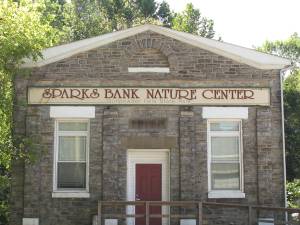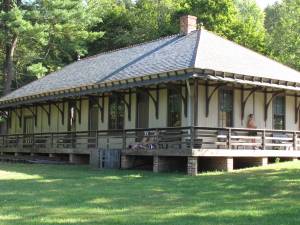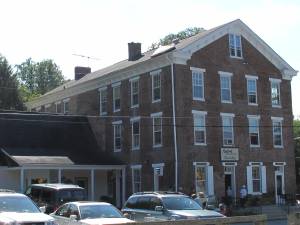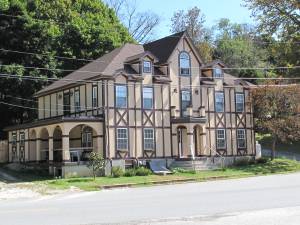By: Tim Connor
You can still hear the railroad if you listen carefully. More recently it’s the sound of jogging feet and bike tires crunching the 20 miles of stone known as the Northern Central Railroad Trail (NCR). What was once a railroad that carried supplies for the Civil War is now a beautiful scenic journey through changing foliage to the Pennsylvania line.
On a sunny, breezy Saturday morning, runners, bikers and walkers congregate on the trail. The sounds of wildlife echo in the distance and the water crashing of the Gunpowder Falls on the rocks. Bikers like Brendan Diakoulas who ride the trail know it used to be an old railroad, but they come for other reasons besides history or fitness.
“I love being outside and the trail is beautiful when the leaves change with the seasons,” Diakoulas said.
Most people who come often have a sense that they are riding on something special. The NCR trail started in 1828 by the Baltimore and Susquehanna Railroad carrying passengers and freight between Baltimore and Harrisburg, Pa. It is also the second oldest railway in the United States. Throughout the Civil War the North used it to transport goods and supplies back up and down the east coast.
“Lots of sections got blown out because the South obviously was trying to hinder us (North) from making (trips) for weapons and stuff like that,” said Gary Wilkins, Station Master of the historic Monkton Train Station.
The most significant person to ever ride the rails was President Abraham Lincoln.
“Lincoln actually rode it twice, once alive and once dead,” Wilkins said. “(He also) used it and another railway to get to Gettysburg to give the Gettysburg Address. People were crying and waving as the train passed (with his body aboard heading to Illinois),” he said.
Up until the 1950s, the railway was used for passenger service. There were two commuter trains known as the Ruxton Rocket and the Parkton Local.
“That was like the light rail today, (people) commuted to and from work,” Wilkins said.
By the 1970s the railroad still operated, but only carried freight as passenger service stopped in 1959.
“In 1972 there was (Hurricane) Agnes,” said Don Gogniat, Vice President of the York County Trail Authority. “It pulled out most of the bridges, so the railroad stopped running,” he said.
In the 1980s, the trail was still an abandoned railroad and people would illegally dump tires and all types of other trash on the trail. Even today people continue to illegally dump their waste anywhere on the roads or on the trail. The most common form of illegal waste are old tires left by the side of the road, Wilkins said.
The Department of Natural Resources bought the land through a project known as Open Space and took over the abandoned railroad at first to protect wildlife and the watershed of the Gunpowder. A big cleanup effort ensued and the land was made into a fitness trail. The NCR trail opened in December 1984.
In 2008, the NCR trail was renamed the Torrey C. Brown Trail.
“Torrey C. Brown was the Secretary of the Department of Natural Resources,” Wilkins said. “He was real vital in purchasing this land and I think it was like his baby and the whole idea itself (was his), so they dedicated it to him,” he said.
Today the trail is vibrant and full of life with many places along the trail to park and pick up the trail. Over 1 million people visit each year.
The NCR trail begins at a parking lot on Ashland Road in Timonium. Ashland is named for the Ashland Iron Company which operated during the mid to late 19th century according to trail markers along the NCR.
Paper Mill Road is the next stop on the trail. The parking lot here is larger and on the weekends, these parking lots can get very crowded as the day progresses.

Here is the Sparks Nature Center which used to be a bank. This center houses animals including turtles and frogs. (Photo by: Tim Connor)
If you continue along the NCR trail another three miles you will come upon Sparks, Md. While there take in all of the beautiful views and even see an old iron one lane car bridge. Just below the bridge is a path that leads to the water and if you’re lucky you can see some interesting birds or fish. Also located in Sparks is the Nature Center. This nature center houses a number of animals including turtles, snakes and frogs. The Nature Center is open on summer weekends from 10 a.m. to 4 p.m. and is available to school groups on request.

This is the Monkton Train Station on the NCR trail. This is the highlight of the trail. The building includes a museum and bathrooms. (Photo by: Tim Connor)
Up ahead another three and a half miles is historic Monkton. This is probably the most important part of the trail. In Monkton lies an old train station that has been converted into a museum and a gift shop. It also has a bathrooms and water fountains to refresh yourself on your trip. The town has been around since the 1600’s and was first known as Charlottestown.
“The Third Lord of Baltimore, Lord Calvert, acquired 10,000 acres of property,” Wilkins said. “He split it into 10 acre plots and had sold them to people to farm it and he profited off of it,” he said.

Inside the Monkton Train Station Museum where there is loads of information about the railroad. (Photo by: Tim Connor)
Later in the mid 1800s, when the trail was a railroad the town grew to a size of 40 people and the name was changed to Monkton. Across the street from the train station a hotel was built.
“People said ‘why do we need this big hotel?’ but people came here for vacation,” Wilkins said. “They came out to the country instead of Baltimore,” he said.

This is the old Monkton Hotel which is now full of other businesses including a general store. (Photo by: Tim Connor)
The train station was a 24/7 operation. Trains operated at all hours of the night. It was the duty of the train station master to give messages to trains going by about potential problems they could face.
“If there was an accident down here or there was a train changing direction the station master would then use a pole and literally just hold it up as the train went by and the conductor would reach out and grab it,” Wilkins said.

The pole on the far left is what the station master would use to deliver messages to trains. (Photo by: Tim Connor)
Autumn Kahl, who also works at the Monkton Train Station, is a regular on the trail when she is not working.
“I do some biking and a little bit of hiking,” Kahl said.
Kahl and Wilkins are both naturalists and give talks and tours throughout the summer, mostly to children.
“(I like) programming and talking to the different kids and I guess knowing you can make a difference in if not their whole views of the environment, their day at least,” Kahl said.

This is the other side of the Monkton Train Station. While you enjoy the museum, keep your bike locked in one of these racks. (Photo by: Tim Connor)
The Monkton Station is open Wednesday through Sunday from Memorial Day to Labor Day. The station is also open on weekends in the spring and fall. Call (410) 592-2897 as hours change.
After leaving the train station behind up ahead is the town of White Hall. Now just a quiet rural town, with remnants of what used to be a center for great business is now full of old buildings and a parking lot.
White Hall was once a commercial center in a farming town. There used to be three stores, a feed mill, a bank, a grist mill and a paper mill here according to the NCR trail markers. The feed mill was a five-story structure and served as a community landmark for 71 years until it was burned down by an arsonist in 1974. The property is now used by the Department of Natural Resources. The White Hall Bank is still standing and operated until 1958. Today the bank is a residence for one of the park’s rangers. The 16- room White Hall Hotel is also still standing and is now a private residence.

This is the old White Hall Bank and is now primarily used by one of the park’s rangers. (Photo by: Tim Connor)
The last three stops on the trail are Parkton, Bentley Springs and Freeland, Md. which is right before the Pennsylvania line. These three spots are out in open space in the country. Bring your camera and take in some breathtaking scenery or keep pedaling ahead.
Although the NCR trail ends after the Freeland stop, it actually extends another 20 miles into Pennsylvania where it turns into the York County Rail Trail. About two miles above Freeland is historic New Freedom, Pa. It is a small friendly town and in it lies another historic train station. Inside is a timeline of the railroad, plenty of pictures and various railroad memorabilia. They even have an old scale that still works. If you’re lucky you can talk with station volunteer and train expert David Smith. Smith also dresses the part of a train engineer.

Ask David Smith (pictured here) anything about trains and the rail trail. He is a wealth of knowledge. (Photo by: Tim Connor)
“What can we do to make this more interesting?,” Smith said. “Why don’t I get an outfit and dress up like a fireman? I go to an engine show and find, guess what?, roundhouse overalls. I started dressing like this and it got the attention that was needed,” he said.

These two cabooses used to ride the rails of the Northern Central Railroad. Now they are apart of the New Freedom Museum. (Photo by: Tim Connor)
Outside the old train station are two large, red cabooses that are also a part of the museum. There are plenty of children climbing and walking through the trains and museum.
“I love to watch little kids,” Smith said. “They’ll go around to the other end of that cart and peek around to look at us. Then of course they go for the buttons. They love the buttons,” he said as he shows me the buttons he usually wears on his chest.
For New Freedom Museum hours check out their website as hours change monthly.

These signs were known as whistle signs. This let the engineer of the train know when to blow his whistle. These are still located throughout the NCR trail. (Photo by: Tim Connor)
The most important part of the trail is the people that use it regularly.
“The rail trail is the friendliest place,” Gogniat said. “More people stop and say ‘hello.’ More people smile at each other on the rail trail than other place…This is a big deal,” he said.
Things to keep in mind while on the trail
1. Bikers yield right-of-way to pedestrians and horses. Pedestrians yield to horses.
2. 15 mph is a recommended maximum speed.
3. Stay to the right. Ride or walk single file when necessary to accomodate other users. Move off the trail when stopped.
4. Pass on left after giving audible signal.
5. Pets must be leashed at all times. Pick up after your pet.
6. Children under 16 years of age are required by law to wear a bicycle helmet.
7. Obey all signs and traffic control devices.
Above taken from Gunpowder Falls State Park pamphlet.
For more interesting stories check out my other blog here.








My favorite thing about this post is the pictures posted. It goes great with your story and really help the reader get an idea of the Gunpowder Falls State Park. Another thing I thought was well done was the descriptions you gave along with the pictures.There is a story itself with the pictures and to go a long with the pictures.
LikeLike
I love how you integrated all the pictures into the story. It was also a very descrpitive story, full of interesting detail. However, it did tend to drag at some points.
LikeLike
Great peice Tim. The detail and background research really shines throughout the piece. As others have said the incorporation of picutres is a great addition and go hand-in-hand with your story. Have a great winter break.
LikeLike
I love this article. I will admit that when you first read it in class that I was a little bored. It wasn’t until you mentioned Gary Wilkins that got my attention, I have known him for years. After listening to the rest of the story and rereading it now it really made me want to go check out some more historical places in Maryland. Great work.
LikeLike